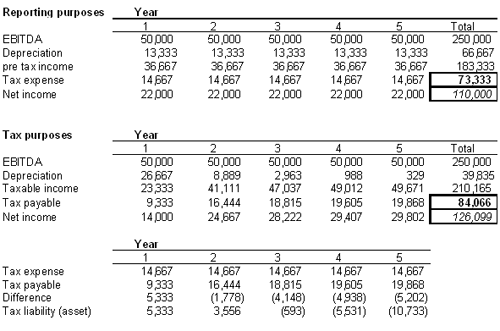CFA Level 1 - Liabilities
If the tax rate changes, then under the asset-liability (or balance sheet) method, all deferred tax assets and liabilities must be revaluated using the new tax rate that is expected to be in place at the time of the reversal.
An increase in the expected tax rate at time of reversal will create a larger tax burden than expected for the company once the transaction is reversed. That said, the current tax expense also increases. This will have a negative impact on current net income and decrease stockholders' equity. A decrease in the tax rate will have the opposite effect.
Example: Company ABC has an EBITDA of $50,000 in the first five years of operations. To generate this income it purchases a machine for $40,000, with no salvage value at the beginning of year 5. The equipment has a five-year life. For tax purposes the company uses the double-declining depreciation method and uses a straight-line depreciation for financial-reporting purposes. At the time of purchase, the estimated tax rate at time of reversal was 40%.

In year 2 the tax rate at time of reversal is estimated at 20%.
Taxes payable = new tax rate * taxable income
= 20% * $41,411= $8,222
Deferred taxes = new tax rate * (DDM-SL)
= 20% * ($8,889-$13,333)
= ($899)
Benefit from tax rate in year 1 = [$42,500* (40%-20%)] - [$30,000*(40%-20%)]
= $1,250
Tax expense = tax payable in year 2 - decrease in deferred taxes in year 2 - benefits from tax rate on year-1 taxes
= $8,889+$899-$2,667= $4,667






0 comments:
Post a Comment